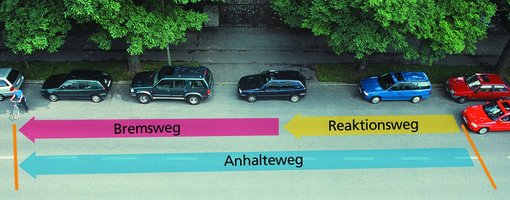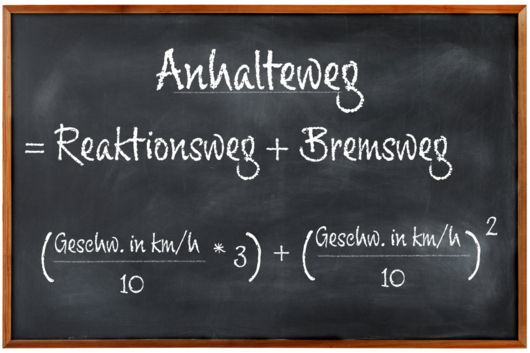The stopping distance
Anyone who thinks about speed must of course also deal with stopping. Therefore, the calculation of the stopping distance is one of the most important formulas during your driver's license training.
In this article you will learn what the stopping distance is and how it can be calculated - so you are fit for the driving test!
Definition of the stopping distance
The stopping distance is the complete distance from the point at which a danger is detected to the point at which your vehicle comes to a standstill. Consequently, the stopping distance results from the addition of the reaction distance and the braking distance.
The actual stopping distance can vary greatly depending on the driver's ability to react and the quality of braking. For the training in the driving school, however, the rule of thumb for the stopping distance is completely sufficient.

Formula for calculating the stopping distance
If you want to determine the stopping distance, first calculate the reaction distance with the corresponding rule of thumb and add the braking distance to this distance. In the case of a hazard braking, the braking distance is additionally divided by 2.

Formula stopping distance - normal braking:
[(speed in km/h : 10) x (speed in km/h : 10)] + [(speed in km/h : 10) x 3] = stopping distance (normal braking)
If a vehicle moves with 100 km/h, the complete stopping distance is 130m, because:
Reaction distance 30 m + braking distance 100 m = 130 m stopping distance.
At half the speed, i.e. 50 km/h, the stopping distance is considerably less:
15 m reaction distance + 25 m "normal" braking distance = 40 m stopping distance.
Formula stopping distance - dangerous braking:
[(speed in km/h : 10) x (speed in km/h : 10)] : 2 x [speed in km/h : 10] x 3 = stopping distance (dangerous braking)
If a hazard braking manoeuvre is carried out, the stopping distance is 80 m, as the stopping distance is reduced to 50 m, while the reaction distance remains the same.
Calculating against speeding
Even if these formulas sound theoretical, it is essential for drivers to understand them. Numbers can be used to illustrate why it is so important to observe speed limits.
Did you know that at 60 km/h you already have a braking distance four times as long as at 30 km/h? What's the reason? The braking distance increases exponentially to the speed, not linearly. At a speed of 30 km/h the car is already at nine metres, while at 60 km/h the braking distance is already 36 metres.

Find your driving school
You don't just want to study driving theory? Find your driving school near you now and soon get behind the wheel yourself.
![[Translate to English:] [Translate to English:]](/fileadmin/_processed_/5/d/csm_Autofahren-Fussganger-Bremsen-AdobeStock-132814525_cf0c4b6443.jpg)
![[Translate to English:] [Translate to English:]](/fileadmin/_processed_/a/1/csm_Vollbremsung-Gefahrbremsung-Bremsen-AdobeStock-234319817.jpg_965eb39c4a.jpg)